
A range of vacuum gauges is available, depending on the measurement range required
The range of vacuum pressure accessible to measurement extends from atmospheric pressure (about 1000 mbar (750 Torr)) down to 10-12 mbar/ 0.75•10-12 Torr, i.e. it extends over 15 powers of ten. The instruments used for measuring the pressure within this wide range are called vacuum gauges. For physical reasons it is not possible to create a single vacuum sensor through which it might be possible to perform quantitative measurements within the entire pressure range. Therefore, a variety of different vacuum gauges are available, each with their own characteristic measurement range which commonly extends over several powers of ten.
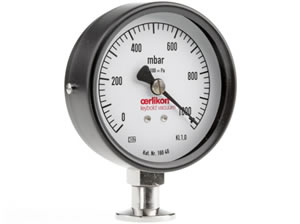

BOURDONVAC
Rugged Vacuum Gauges with Mechanical Display
With a common mechanical vacuum gauge, the pressure is determined directly by recording the force acting on the surface of a diaphragm. In this case of direct (or absolute) pressure measurements, the readings obtained through the vacuum gauge are independent of the type of gas and the pressure which is to be measured. The pressure range is approx. from 1000 mbar (atmospheric pressure, 750 Torr) to 1 mbar (0,75 Torr).
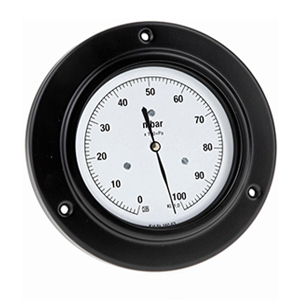

CAPSULE Gauge
Mechanical gauges operate with a diaphragm connected to a dial
Hermetically sealed, evacuated and thin-walled diaphragm capsule located within the instrument. As the vacuum pressure reduces the capsule bulges. This movement is transferred via a system of levers to a pointer and the pressure can be read off on a linear scale.
As CAPSULE gauges are better to read lower pressures, we offer it with two full scales:
- 1000 to 1mbar (750 to 0.75 torr)
- 100 to 1 mbar (75 to 0.75 torr) with the later giving better resolution at the lower pressures.
It also comes with either:
- a DN 16 ISO-KF flange to connect directly to a vacuum system
- a 10 mm diameter hose nozzle with integrated isolation valve for panel mounting and use on packing machines.
As the measuring cell is hermetically sealed against the outside environment, it is not affected by changes in atmospheric pressure, making it more reliable at pressures below 10 mbar/torr.
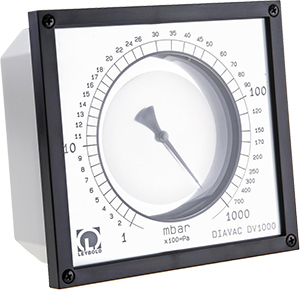

DIAVAC DV 1000
Diaphragm gauge
Where the BOURDONVAC is great with corrosive media, but affected by atmospheric pressure, and the capsule gauge is less capable with corrosive media, but not affected by ambient pressure, the DIAVAC DV 1000 combines the best features of both into a single gauge.
The DIAVAC DV 1000 is made for rough pressure measurement in corrosive environments as the sensitive parts are in a sealed reference volume and the materials exposed to vacuum in the sensing cell are Stainless steel/FPM. To increase the accuracy of the gauge: each scale is individually calibrated for optimum performance.
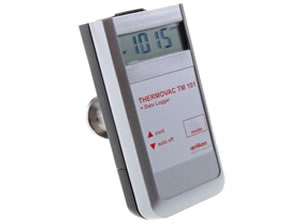

TM 101 & PV 101
Portable handheld Gauge
The digital compact PIEZOVAC PV 101 and THERMOVAC TM 101 combine high-quality sensor technology with modern processor technology in a handy design. The integrated screen allows for spot checking without the need to have a separate local display. Even operation while completely under vacuum conditions is possible so you could monitor how well your vacuum packing machine is performing!
Owing to their ba ttery mode, alongside optional 15VDC mains power adaptor, the devices can be attached and operated at any pressure measuring point, and directly display or store up to 2,000 values for later evaluations and visualizations via the optional VACUGRAPH software. You can also purchase a dedicated carry case for when it is integrated into a wider work-kit.
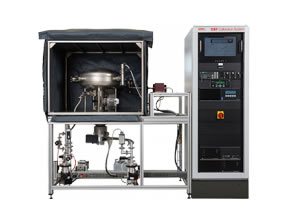

CS3 & CS7
Vacuum gauge calibration systems
Process reliability is possible with regular checks, adjustments and recalibration of vacuum gauges and sensors which must be calibrated at regular intervals. Setting the devices to an initial value is an important component of quality assurance. Calibrated gauges are particularly used where high requirements are made on reproducibility and compatibility as well as on the quality of testing processes. Also, if a clear reference is required for lots of existing pressure measurement devices, calibration is a must.
The CS calibration systems from Leybold enable customers to check and calibrate the defined and required measurement accuracy of their vacuum gauges themselves. This can follow the standards of the German Accreditation Body (DAkkS) or any international standard, whereas the required measurement accuracy must be defined by the users.